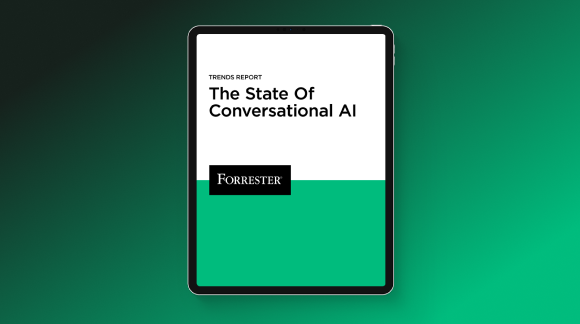The Messaging Mandate
This is Part 1 in a 3 Part Series focused on The Messaging Mandate. This article highlights why your company should consider adding Messaging to your customer service organization. Part 2 will discuss the criteria against which to rank consumer to business messaging providers. Finally, Part 3 will outline what to consider to successfully implement messaging. We hope you enjoy the series.
Messaging is not new…in fact, it has been around for quite some time. We have been using messaging to send messages, photos, and emojis to our friends and family for over 20 years–to the tune of over 6 billion text messages daily in the U.S. alone (Forrester). According to Pew Research, 97% of Americans use text messaging on a daily basis, making text the most widely and frequently used app on smartphones. So if text messaging is not new, what is new? The answer: Consumers messaging customer service.
The vast majority of messaging occurs between individuals, friends, and family members. Messaging a company is just taking off. Business text messaging is simply the ability for consumers to contact businesses and exchange information over mobile devices. Messages can be sent as text (Short Message Service/SMS), pictures, video, or audio (Multimedia Messaging Service/MMS) over a variety of messaging apps like Facebook Messenger, Kik, etc.
Done correctly, messaging is a powerful tool to help consumers connect with businesses – especially when it come to customer service.
1. Customers Expect It
Consumers are demanding the ability to communicate via messaging with brands and businesses. Consumers don’t want to just receive messages from businesses, they want the ability to message them back. No longer is messaging simply a one-way channel for companies to market to consumers. Customers now expect to be able to initiate a two-way, one-to-one conversations with the companies and brands they use.
In fact, the majority of U.S. consumers would prefer texting over the current methods of reaching customer support (eWeek). As Forbes writer, Micah Solomon, stated: “ If your customers won’t even call Mom on the phone anymore (they’re texting her instead), why are you forcing them to call your business on the phone any time they need customer service or support?” Consumers prefer messaging as a channel of communication and when given a choice, they use it.
2. It’s a Competitive Advantage
“The customer experience is the next competitive battleground.”
– Jerry Gregoire, Chief Information Officer at Dell.
According to Gartner, 89% of companies plan to compete primarily on the basis of the customer experience and the main driver of the customer experience lands smack dab in the middle of the customer service and support organization. In fact, Harris found that 88% of customers prefer doing business with a company that offers quality customer service over a company that has the latest and most innovative products. A good product is expected of every company. Innovative and quality customer service is the competitive advantage.
With the continued focus on delivering great experiences via customer service, it is critical that companies constantly innovate and adapt their service approach to exceed customer expectations. The interest, preference, usage, and demand for consumer-to-business messaging is already evident and companies that don’t already offer messaging are quickly falling behind.
Messaging is not only what consumers want, but it is also what businesses should want. Adding messaging as a customer service channel delivers significant cost savings due to offloading phone calls, while improving customer satisfaction (CSAT).
3. Significant Cost Savings
Activating messaging for customer service not only provides a better experience for the customer, it is also much more efficient for agents compared to phone calls and emails. Messaging is cost-efficient and time-efficient for customer support teams for many reasons:
- Agent supported phone calls cost several dollars per conversation, while agent supported texts cost pennies per conversation. (Forrester & ContactBabel)
- Implementing a messaging channel allows companies the ability to deflect calls to a lower cost channel. It is common to see a 20% or higher offload of phone calls to messaging.
- Messaging allows each agent to handle multiple conversations simultaneously, improving productivity over one-to-one voice calls. Additionally, agents can typically handle 6-8 messaging conversations at once due to the asynchronous nature of messaging, dramatically improving agent productivity.
- Agent familiarity and comfort- Messaging allows agents to use an interface they are already familiar with because they message their friends and families too. This makes it easy for agents to quickly come up to speed to support a new channel.
Customers want it. Agents understand it. It makes agents even more productive and saves you money. If your business isn’t taking advantage of the opportunity to activate Messaging to interact with customers, what could possibly be holding you back?
4. Higher Customer Satisfaction
We are now living in a world where businesses need to move past being customer-centric or customer-focused into being customer-obsessed (Forrester). Customer-obsessed companies focus on customer satisfaction and retention, understanding that these measurements are key metrics for any company trying to compete.
It is notable then that texting is the highest rated contact method for customer satisfaction compared to all other communication channels (Text – 90%; Phone – 77%; Facebook – 66%). (eWeek).
Why is text so highly rated? Because it blends the real-time answers of a phone call with the portability of a mobile device. The customer benefits from the convenience and control they get from messaging. Their interaction with a company can happen at their pace, on their terms, instead of on the company’s terms. With messaging, consumers are able to get customer support at the speed of life.
With mobile devices, customers can interact with an agent from wherever they are, even in places where there may not be an internet connection. Unlike web chat, customers no longer need to be tied to their computer. Wherever they go, the conversation can continue.
While voice offers the advantage of “real time” interaction, it usually occurs after the customer has navigated an IVR system or been placed on hold. Studies show that customers are increasingly frustrated by being placed on hold. Texting is as “real-time” as a voice call, but without the hold times. The immediacy of communication brings about a feeling of connection and importance, allowing brands to be more human and relatable.
Conclusion
Consumer’s preference for messaging in both their personal and business lives continues to grow, with no end in sight. They appreciate that texting is a fast and efficient customer support option, and expect businesses to respond accordingly. Customers want real-time responses to their support issues. By adding messaging to your Contact Center, managers and agents have the tools necessary to provide a better customer experience, while saving money.
About Us
Quiq connects customers and companies via Messaging (Facebook Messenger, SMS, and Kik), resulting in more efficient customer service and happier customers. Learn more about Quiq today at quiq.com, or email sales@goquiq.com for a free product demo.





